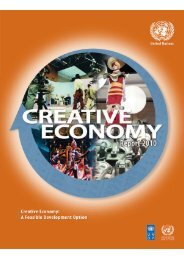study
study
study
You also want an ePaper? Increase the reach of your titles
YUMPU automatically turns print PDFs into web optimized ePapers that Google loves.
Figure 10: Percentage of respondents who are concerned about the trustworthiness of people and information<br />
online<br />
80<br />
The New Internet World<br />
70<br />
60<br />
Percentage<br />
50<br />
40<br />
30<br />
20<br />
10<br />
0<br />
ZAF IND MEX US BRA ESP AUS/NZ ITA CHN UK CAN GER FRA<br />
Notes: See page 1 for country abbreviations and sample sizes. Blue bars indicate percentage of respondents who are very or extremely concerned about "being<br />
misled by inaccurate information on the Internet" or by "people on the Internet lying about who they really are".<br />
17<br />
Figure 11: Concern about the trustworthiness of people and information online according to Internet diffusion<br />
100<br />
80<br />
Percentage<br />
60<br />
40<br />
20<br />
0<br />
IND<br />
ZAF<br />
MEX<br />
CHN<br />
BRA<br />
ITA<br />
ESP<br />
FRA<br />
US<br />
CAN<br />
GER<br />
UK<br />
AUS/NZ<br />
Countries in order of Internet diffusion<br />
Notes: See page 1 for country abbreviations and sample sizes. Blue bars indicate percentage of population online (2010); black line with white markers indicates<br />
percentage of respondents who are very or extremely concerned about "being misled by inaccurate information on the Internet" or by "people on the Internet<br />
lying about who they really are". Internet diffusion rates are according to the World Internet Statistics, last updated on June 30, 2010 (http://www.internetworldstats.com/).

















